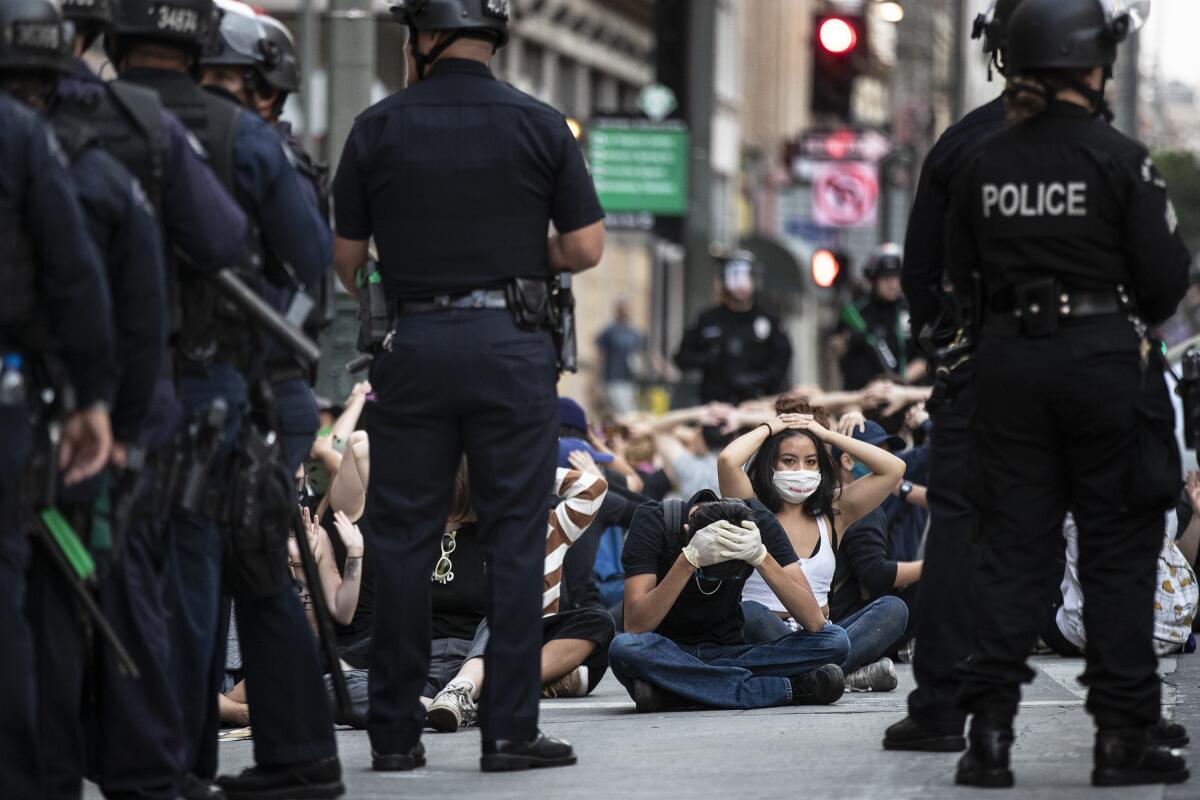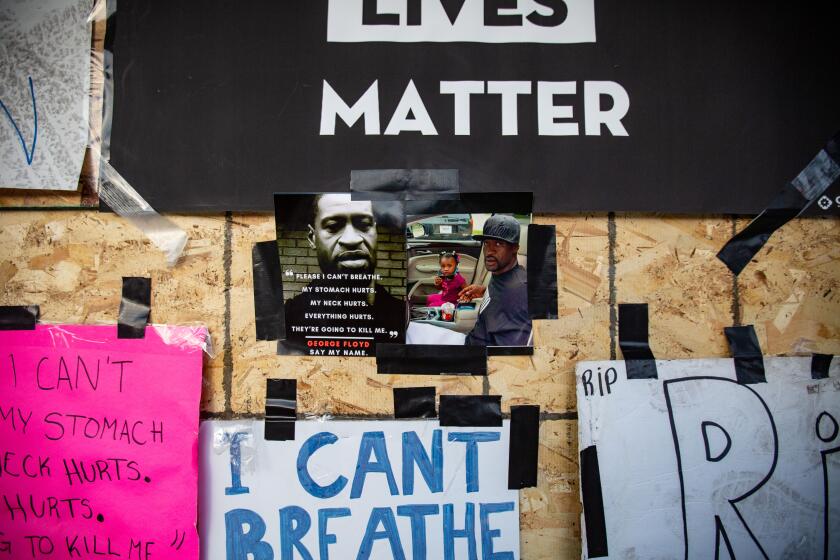Commentary: Under fire for protest coverage, local TV news tries to learn from its mistakes
- Share via
The curfew has lifted, Los Angeles. But what has changed?
When breaking reports about the widespread protests of police brutality against black people first interrupted regular network TV programming last week, the footage looked like it was pulled from an analog-era vault.
Protesters marched though downtown Los Angeles chanting “No justice, no peace” as they did in 1992, during another explosive reckoning triggered by the videotaped beating of an unarmed black man by police. Blazing fires and broken shop windows were reminiscent of scenes from the 1994 Northridge quake. News choppers circling above police activity on the 405 recalled O.J. Simpson and his white Bronco.
Today, however, things do look different ... at least on local TV news. The brutal asphyxiation killing of George Floyd while in the custody of Minneapolis police last week, and ongoing demonstrations against systemic racism, injustice and police brutality, have forced stations to rethink age-old coverage tactics and have flipped narratives about old versus new media on their heads.
Compared to the awful power of the video of George Floyd’s death, or even the intimate address of Trevor Noah, CNN, MSNBC and Fox News are utterly ineffectual.

The punching bag of journalism, local TV news moved from the periphery to center stage last Friday when it began frenetically covering a city that’s no stranger to corrupt law enforcement, civil unrest, racial profiling and, yes, even looting.
While the images broadcast by KTLA, Fox11 and their competitors may have looked similar to another painful period in the Southland, there is something different this time, eight days after Floyd’s killing eclipsed COVID-19 as our nation’s top crisis and nearly 15 years into the Twitter era.
Until now, social media has been assumed to be the tool of immediacy for breaking news. But for better or worse, local media offered what Instagram and Facebook could not in the heat of recent unrest: a continuous news feed from verifiable sources, void of the extremist meddling, agenda shaming and unsourced outrage videos that make information scrolling such a perilous pursuit in 2020.
Platforms like Twitter have proved to be a civic blessing, exposing what the rest of media misses or buries while revolutionizing the art of organized protest. It was an invaluable tool of transparency during the 2014 police brutality protests in Ferguson, Mo. But there’s also a reason why social media is the favored misinformation conduit for bad actors, white supremacists and President Trump, a reality that’s glaringly clear right now.
Inciting outrage is as easy as pressing “tweet,” no matter if the content is utterly false. This week hundreds of Facebook employees protested the company’s decision to give President Trump’s lies about the danger of mail-in voting a pass. They stopped working and walked out in a show of solidarity. Just a week earlier, Twitter finally made the decision to flag Trump’s posts that violated its rules about glorifying violence.
The standards and rules that make traditional local news so frustratingly stodgy and slow to change are also the ones that make it harder to manipulate.
And when ABC7, NBC4 and KCAL 9 began streaming back-to-back reports from Melrose Avenue, Santa Monica, Van Nuys Boulevard, Long Beach and downtown L.A., events unfolded so quickly there was little time to editorialize the way they did back when phones had cords, newsrooms had big budgets and the 5 o’clock news was king.
Cameras — and viewers — witnessed impassioned calls for change by marchers of all colors, angry shouting matches between millennials and cops, and peaceful folks hit with LAPD rubber bullets and tear gas. They saw reporters attacked by masked instigators, demonstrators attacked by police, police attacked by demonstrators and Angelenos protecting or attacking one another. There was vandalism and cleanup, looters taking selfies and people acting selflessly.
There was so much activity it contradicted much of social media’s binary messaging — all protesters/cops are good/bad — while offering context around short videos posted by civilians in the center of the movement.
That’s not to say the live reports, later edited for truncated newscasts, were always the epitome of fair reporting. The old adage ‘If it bleeds, it leads’ is alive and well, as is the institutional bias that has long caused so many wrenching stories like Floyd’s to be underplayed, defended or ignored.
Joe Biden’s remarks on the death of George Floyd struck a sharp contrast with the rudderless Donald Trump on Friday as nationwide protests continued.
In the early going, local press, including this paper, often seemed to pay more attention to violent instigators and looters than to the overwhelming majority of peaceful protesters. TV reporters embedded behind police lines more than they embedded with activists. Cops were shown as protectors while demonstrators of color were portrayed as the problem. Coverage was dominated by the uprising’s most outrageous moments. Commentary was often from the white perspective and aimed at easing the fear of white folks.
The pressure and outrage of a nation, however, is shifting those dynamics, which evolved on screen over the week. Reporters who used the terms “protesters” and “looters” interchangeably had been called out so vigorously that by the time a state of emergency was called in Los Angeles, reporters were making concerted efforts to differentiate between marchers and “smash-and-grab crews.” Clips of police using excessive force against demonstrators, and also marching next to them, have been pushed to the fore. Chyrons now use terms like “peace marches” rather than “violent protests” below footage of large crowds.
Is it the massive change citizens are agitating for? No. But given how hard it is to pin down where we are right now in terms of progress and pushback, it’s at least one small win worth noting.
As for L.A., we’re a city that’s hard to define in the most uneventful of times. We’re congested and sprawling, full of natural beauty and absurd vapidity, individualist culture and deep economic disparity. This week the city may have looked like it did in a darker era. But change on the ground is fast transforming that view, even through the eye of local news camera.
More to Read
The complete guide to home viewing
Get Screen Gab for everything about the TV shows and streaming movies everyone’s talking about.
You may occasionally receive promotional content from the Los Angeles Times.






